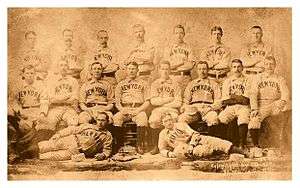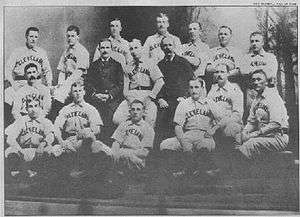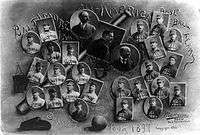Temple Cup
| Temple Cup | |
|---|---|
| First awarded: | 1894 |
| Last awarded: | 1897 |
| Current location: | National Baseball Hall of Fame and Museum, Cooperstown, New York |
| Last holder: | Baltimore Orioles |
| Most Cups: | Baltimore Orioles (2) |
The Temple Cup was a cup awarded to the winner of a best-of-seven, post-season play-offs championship tournament for American professional baseball for the National League of Professional Baseball Clubs (known as the National League - established earlier in 1876) and awarded four times from 1894 to 1897. The 30-inch-high (76.2 centimeters high) silver cup cost $800, ($21.8 thousand in 2017 dollars[1]) and was donated by coal, citrus, and lumber baron William Chase Temple (1862-1917), a part-owner of the Pittsburgh Pirates at the time. [2]
Much like the long running Stanley Cup of ice hockey in the National Hockey League and the Temple Cup's predecessor to the professional baseball team champions, the Dauvray Cup (1887-1893), (awarded seven times in the name of the donor, famed stage actress of the day, Helen Dauvray (1859-1923)), there was only one actual Temple Cup passed along to each baseball season's winning team and city.
Since there was only one major league at the time with the folding of the previous American Association 1882-1891, so the series was later played between the first and second-place teams of the surviving NL.[3] The second-place team defeated the first-place team for the Cup in three of the four series that were played. The Temple Cup was also known as the World's Championship Series. If one team won three titles, that team would have permanent possession of the Cup, later given to the city of Baltimore for their .
Having moved over with several other AA strong franchises to join the senior National League after the 1891 folding of the American Association after ten seasons in the AA since 1882, the frequent champions and powerful scrappy teams of the Baltimore Orioles continued their winning ways from the old AA, capturing unprecedented three NL pennants in a row in the [[1894-1895-1896, and winning the Temple Cup also. Owner/manager Ned Hanlon (1857-1937), a Baltimorean and one of the most talented baseball men of the sport's early era ran the "Birds" with talented players like "Wee Willie" Keeler (1872-1923), Wilbert Robinson (1863-1934), and John McGraw (1873-1934). McGraw was later player/manager/owner with the early American League charter member team (and third to carry the Orioles name) of the new Baltimore Orioles of 1901-1902, one of the 12 original franchises in the new AL when reorganized in 1901, from the former Western League (on the minor level, 1885-1899) under activist first president Ban Johnson (1864-1931).
After the 1903 "peace pact" between the two major leagues, ending the "war" between them, recognizing each other as equal in stature, accepting a joint policy on player contracts and beginning a "best-of-seven" tournament of champions between them resulting in the modern inter-league World Series for the next century whose championship trophy replaced the old Temple Cup and soon exceeded its esteem. Also each league was allowed a franchise in the nation's largest city, so McGraw was responsible for the new AL Orioles team to move that year of 1903, after only two seasons along the [[Chesapeake Bay5 to New York City to represent the AL, becoming the New York Highlanders, renamed a decade later as the New York Yankees. McGraw went on and later returned to the NL as owner/manager of the famous opposing New York team in the borough of The Bronx with the legendary New York Giants competitive in the early 20th century.
History

In the 1880s, there had been postseason play between the winners of the National League and the American Association, but in 1892 the National League absorbed the Association, becoming a 12-team league, and played a split season. In 1893 the Pittsburgh Pirates finished second to the Boston Beaneaters (today's Atlanta Braves). The Pirates' president, William Chase Temple, felt that his team should have the option of having a playoff series to claim the title. As a result, Temple had his $800 trophy minted and he donated it to the league. The revenue was to be split 65% to 35% between the winner and the loser, but the players of the first series (in 1894) agreed to split the money evenly. However, after the series the New York Giants (now the San Francisco Giants) cheated some Baltimore Orioles players out of their money, tainting the Cup and prompting Temple to sell the Pirates in disgust.[4]
Lack of enthusiasm on the part of the players doomed the series; their apathy spread to the fans, few of whom attended Temple Cup games in later years. Interest in the series faded quickly, as it seemed artificial, with the second-place team winning three of the four series. The Baltimore Orioles appeared in every Temple Cup series, winning the last two and thus coming the closest to gaining permanent possession of the trophy. The last Temple Cup series was played in 1897. However, the concept was revived in 1900 with the Chronicle-Telegraph Cup.
After the Temple Cup series ended, the National League returned the trophy to Temple, whose Pirates team never finished higher than sixth place in the standings during the Cup's existence. In 1939, The Sporting News tracked down the Cup, finding it in the possession of a Temple family member in Florida. The Cup was displayed at the 1939 New York World's Fair. The Temple family later sold the Cup for $750 to the National Baseball Hall of Fame and Museum, where it remains today.
Cup winners
Summary of Temple Cup Series
See also
References
- ↑ Federal Reserve Bank of Minneapolis Community Development Project. "Consumer Price Index (estimate) 1800–". Federal Reserve Bank of Minneapolis. Retrieved January 2, 2018.
- ↑ Ceresi, Frank. "The History Of The Temple Cup". BaseballLibrary.com. Archived from the original on 4 July 2015. Retrieved 13 December 2012.
- ↑ https://web.archive.org/web/20070618120506/http://www.baseballhalloffame.org/history/2005/050520.htm. Archived from the original on June 18, 2007. Retrieved May 14, 2007. Missing or empty
|title=(help) - ↑ Lansche, Jerry (1991). Glory Fades Away. Taylor Publishing. ISBN 0-87833-726-1.



